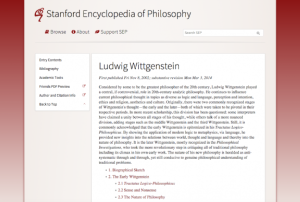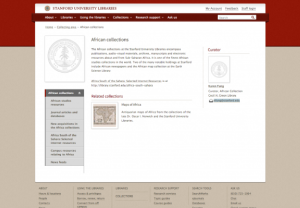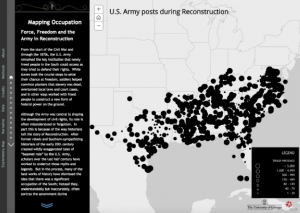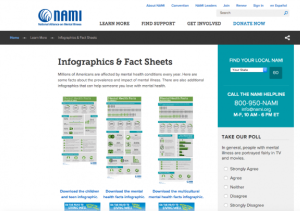Research and Education
Back to Top
|
 |
|
Stanford Encyclopedia of Philosophy: Ludwig Wittgenstein
|
Philosophy |
|
Originally started in 1995, the Stanford Encyclopedia of Philosophy (SEP) has provided students, educators, and the general public with a dynamic trove of information for over two decades. Each fascinating entry is verified and maintained by subject editors, providing an authoritative reference work at no cost to its readers. Consider this entry on Ludwig Wittgenstein, deemed by many to be the greatest philosopher of the 20th century. Wittgenstein was born in Vienna in 1889 into a wealthy family of industrialists. After giving away his wealth, the intransigent and itinerant young man joined the Austrian Army, was captured and held as a prisoner of war, and, in the midst of it all, penned his Tractatus Logico-Philosophicus. Here readers may peruse a short account of Wittgenstein's troubled life and then delve into his philosophy, which has been conveniently divided into early and late periods. Readers will also find Academic Tools that may help with questions about how to cite the SEP, Other Internet Resources about Wittgenstein, and Related Entries from the SEP's bountiful archives. Lovers of modern philosophy will find much to enjoy on this reliable and nuanced treatment of one of the greats. [CNH] |
|





|
|
 |
|
Community College Daily
|
Vocational Education |
|
For readers interested in breaking updates on what's new and important in the world of American community colleges, Community College Daily can provide a fresh perspective. A free publication of the American Association of Community Colleges (AACC), the periodical offers a wide scope. For instance, readers may like to begin with the In Focus section, which highlights students and programs that are fulfilling the promise of community college education, whether that be by transferring into four-year programs, earning practical certificates, or transitioning into top jobs in tech and other fields. The News Topics section features articles on topics frequently making headlines, including categories on Campus Issues, Academic Programs, Sustainability, Funding, Government, and Technology. Recent pieces have asked how tech is changing teaching and learning, examined the possible federal expansion of Pell Grants, and provided an overview of recent improvements in state funding for community colleges. [CNH] |
|





|
|
 |
|
EU Lesson Plans and Teaching Material
|
Social studies |
|
Founded in 1993, The European Union has grown into one of the most significant political and economic forces in the world. For educators who would like to teach about this historically significant partnership of 28 unique but interconnected nations, this web page, hosted by the delegation of the European Union to the United States, offers dozens of excellent lesson plans. Readers may like to begin in either the Grades 9-12 or Grades K-12 sections, depending on their teaching responsibilities, to find lessons on such compelling topics as Geography of Europe, Cultural Diversity, and Structure of EU Government among others. Each lesson is downloadable in PDF format and covers multiple themes, with an introduction, an overview of the "Big Idea," procedures for the lesson, activities, web resources, and quizzes and other assessment tools. Ready-made PowerPoint presentations also accompany each lesson, providing supplemental material to easily enhance the provided curricula. In addition, the EU Teachers' Corner links to dozens of excellent resources, including brochures, presentation slides, links to websites, maps, and booklets. [CNH] |
|





|
|
 |
|
Wired: Science Blogs
|
Science |
|
Wired has been covering technology, tech business, tech lifestyle, and tech products with its special brand of techno-utopianism and hacker wit since its inception in early 1993. It's Science Blogs section, however, is a relative newcomer. Here readers will find the latest in the science of natural disasters, the ins and outs of everyday physics, and explanations of everything from how to race a motorcycle across the United States to what it takes to put rockets into space. Recent articles have presented a vision for a better, realities-driven higher education system, coverage of volcanoes in Chile and Indonesia, a philosophic treatise on the new Star Wars, and some erudite thoughts on how to measure the speed of light. For educators looking for ways to enliven class discussions and inspire students to think again about basic science concepts, these Science Blogs can be an inspiring resource. [CNH] |
|





|
|
 |
|
Transformative Teachers
|
Social studies |
|
These resources, which were designed for middle school students by The Dalai Lama Center for Ethics and Transformative Values at MIT and published on the PBS Learning Media website, can be useful to educators who are interested in helping students develop positive qualities. Each of the approximately three-minute videos covers one of the topics. Readers may like to start with the overview, which explains the program, including a video of students who have benefited from the curriculum. From there, educators may want to navigate to the lessons on cultivating forgiveness, cultivating gratitude, and cultivating self-acceptance. Support Materials, which consist primarily of Teaching Tips, are available for most videos and call up an explanation of the lesson, including how to prepare students for the video, how to generate discussions, and how to engage students in the activities. Other lessons include such gems as Cultivating Leadership Through Self-Acceptance and Forgiveness and Gratitude and the Environment. [CNH] |
|





|
|
 |
|
On Teaching and Learning Mathematics
|
Mathematics |
|
The American Mathematical Society (AMS) was founded in 1888, boasts a membership of more than 30 thousand, and holds the distinction of hosting the largest annual research mathematics meeting in the world. Readers can be assured, then, that this AMS-published blog, which offers ideas on how to teach mathematics to high- and low-performing students, from kindergarten through college, maintains a high standard. Recent posts have included ideas about how inquiry-based learning syllabi might better serve the needs of students, thoughts on how to use social media as a teaching resource, an explanation of the importance of early math education, and a six-part series on active learning in mathematics. Math teachers of all ages and abilities will find much to appreciate on this well-informed and relevant blog. [CNH] |
|





|
|
 |
|
Stanford University Libraries: African Collections
|
Social studies |
|
Librarians, researchers, and students of African studies will find much of interest within the African collections at the Stanford University Libraries. Curated by Karen Fung, the collections feature an impressive array of materials and information about Sub-Saharan Africa. For instance, within the African studies resources section, readers will find topical items sorted both broadly and narrowly, including a list of films and videos that can be watched online or links to Africa-related News feeds from around the web. From the homepage, readers may also link to Maps of Africa, a related collection at the Stanford University Libraries featuring French, English, German, and Greek maps dating back to the mid-1600s. Educators searching for primary sources to enrich their lesson plans will also appreciate the Journal articles and databases featured here. From the African Studies Combined Database Search to AfricaBib.Org, students, educators, and many others will find much to appreciate on this site. [CNH] |
|





|
|
 |
|
NYPL Digital Collections: Navigating the Green Book
|
Social studies |
|
Between 1936 and 1967, a black postal worker from Harlem named Victor Green published an annual directory known as the Green Book. In it, Mr. Green listed businesses that would gladly (and safely) serve African American travelers, including hotels and restaurants, nightclubs and bars, beauty salons and gas stations. Here readers will find an inspiring new project from the New York Public Library (NYPL) that engages public domain collections of the Green Books. Readers may browse covers from the 1947, 1948, 1955, 1956, and 1960 issues, explore the Digital Collection itself, or Map a Trip using aggregated data from a number of the books. This last feature offers the most creative way to navigate the Green Book. After entering a starting point and a destination, the program uses data from the original guides to visualize where black travelers would have been allowed to stop for a drink, buy gas, eat at a restaurant, or sleep. For readers interested in the history of discrimination in the United States, these excellent resources will pay big dividends. [CNH] |
|





|
|
























